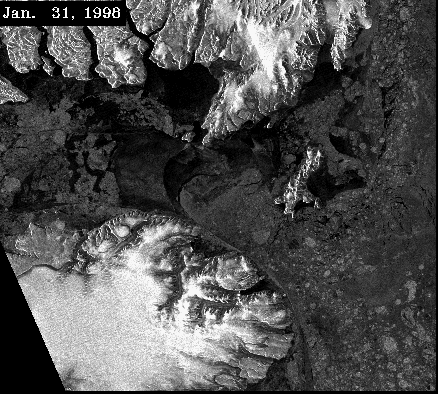 |
 |
| Steffen Home | People | Projects | Publications | Classes | Contact |
| RESEARCH GROUPS @ CIRES > |
The Polynya in Lady Ann Strait, Jones Sound, NW Baffin Bay, Arctic Canada: A Time-lapse movie of RADARSAT images
These are images collected by the RADARSAT sensor (Canada), and distributed by the Alaska SAR Facility (ASF). Thebrightness of SAR (synthetic aperture radar) imagery is related to the roughness and salinity of the surface being measured, amongst other things. Greater brightness indicates increased roughness and salinity. You will notice that open, calm ocean water is very dark (e.g. in inlets, in August), while wind-roughened water is brighter (e.g. on Aug. 4, 11). Glacier ice is relatively bright, however, an increase water content in snow will darken the surface (e.g. in July). Sea ice ranges tremendously in its brightness (Steffen and Heinrichs, 1994*). Go to the slower animation to read about sea ice and the polynya, or area of openwater, in Lady Ann Strait. *Steffen, K. and J. Heinrichs. 1994. Feasibility of sea ice typing with synthetic aperture radar (SAR): merging of Landsat thematic mapper and ERS1 SAR satellite imagery. © Canadian Space Agency (1998) Valerie Sloan, Koni Steffen, and John Heinrichs |
